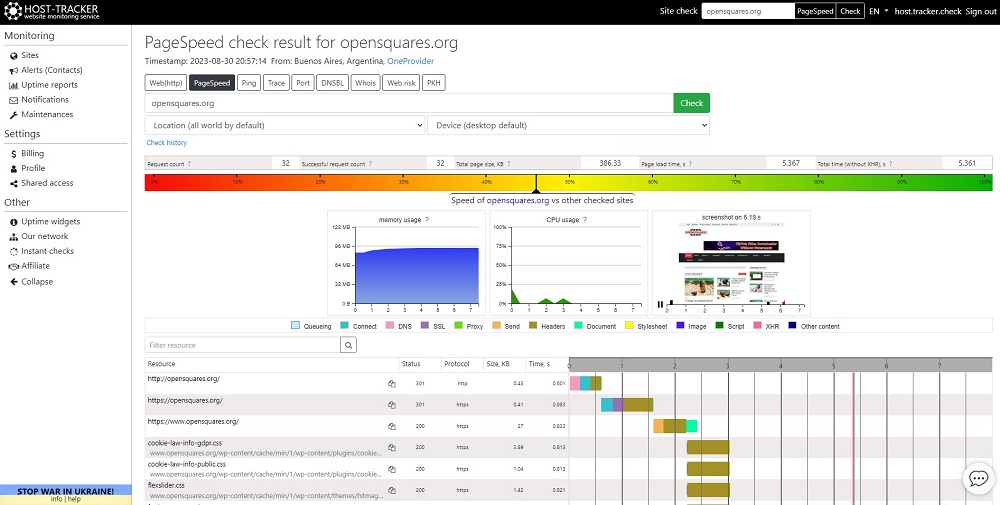
For any business, a website is a necessity required to survive and develop in the modern world, if that’s more than a small local shop. However, even a lot of local shops have one. Therefore, if you’re a business owner, you should understand why it is vital to have a site, what website monitoring is in business, and how it affects the probability of its promotion and development. Otherwise, no matter the size of your company, you simply won’t be able to succeed in those two things, no matter how much money and effort you put into it.
How to Measure Website Performance Metrics?
Website performance, to put it simply, is a set of metrics that are vital for the site’s success. Primarily, it affects the website’s position in SERP (Search Engine Page Results) ratings and advertising queues, not to mention the fact that it very highly affects user satisfaction rate as well as conversion rate. Obviously, no user will keep visiting a poorly performing site, even their favorite one.
Therefore, taking all that into account, it is highly important to measure the website’s performance accurately, compare it to norms and regulations designated by Google, and constantly improve them. This will greatly support all the efforts you put into the promotion and development of the site, as well as help you with maintaining its stable growth.
However, measuring the website’s performance metrics is not as hard as it seems for novices. You only need proper tools and some knowledge about how it works. Basically, to understand the requirements for high SERP ratings, you should use the Google PageSpeed Insights toolkit. It will literally tell you what metrics your site is actually lacking in terms of performance.
With this in mind, you will be able to set up a proper monitoring sequence on a scheduled basis using the powerful website monitoring tool host-tracker provides, for instance. This platform will provide you with all possible tools you might need to check your site’s actual metrics, from basic manual instant checks available for every visitor to powerful automated checks and tests for registered users.
Made in an easy-to-understand and easy-to-configure way, this service is a powerful toolkit designed specifically for website monitoring. To set up a monitoring routine, all you need is to know the metrics you need to keep in check. And the site’s domain name or IP. Coupled with an instant notifications system, HostTracker allows you to keep your website in check without the need to constantly read through reports yourself. The system will send you a message as soon as something happens.
How Does Download Speed Affect Website Performance?
Basically, everything related to the network greatly affects the site’s performance. And if your server has low bandwidth, then it won’t be able to work with large media files and won’t be able to handle the simultaneous presence of a large number of users. Therefore, understanding the simple fact that having a hosting server with a network that has a wide bandwidth is a must for every website will make things way easier in case of future site development or audience increase.
Practically speaking, all modern hosting providers have no problems with bandwidth in itself, but you can encounter such problems if you pick the wrong service plan without any consideration for possible network load. That’s why monitoring the website is very important, especially when owning a business-related site and aiming to make it reach the top of its niche.
For example, shared hosting might have issues with bandwidth, mainly due to the fact that it hosts a large number of websites that share resources. And if some neighboring sites receive a lot of traffic, then your bandwidth could become thinner, and you will have issues with the website loading up to the point of it becoming inaccessible for users.
The same goes for situations when the problem arises on the side of the network. Somewhere in the middle of the route between the user and the server, there could be problems with network connectivity. And it would affect the site’s performance, too. Therefore, the hosting server’s network should be monitored as part of website performance measurement.
Obviously, it’s very important to use the most versatile and powerful toolkit you could possibly get your hands on. It should be able to check everything from a variety of points all over the globe, like the HostTracker platform with its 100+ access points worldwide. Just to ensure that everything is working well from every corner of the world.
All the above does not mention server-side hardware issues. When the server itself is unstable, then the website’s loading speed will become slower. Although it could not be related to bandwidth and downloading speed, sometimes that’s the case, too.
How to Check Website Performance Online
Despite the outer complexity, keeping the website’s performance in check is not too hard. As mentioned earlier, all that you need is to know the site’s IP or domain, know what metrics you should check, and have a reliable and powerful toolkit to do the task perfectly. And usually, the latter is the most neglected part of it. But if you rely on the website tracker from all locations the host-tracker provides, it will handle the site’s performance monitoring with ease.

Basically, with the HostTracker platform, you can pretty easily (and automatically at that) test all the required parameters of the website, the server it’s hosted on, the network it works with, and so on. This service has literally everything even an experienced webmaster could need, except for the very specific tools.
Moreover, this platform works on an automated and scheduled basis and can conduct website diagnostics from more than 100 access points around the world. And all the tools the HostTracker monitoring service has been supported by the instant alerts system that was designed to quickly notify the user responsible for the website’s maintenance as soon as something happens. For any eCommerce or Shopify store, it also becomes absolutely imperative to integrate and install the best-in-class exit-intent technology into a site that helps monitor a visitor’s behavior or buying techniques. This would further enable the company/store to improve upon its user interface and make it more engaging for all first-time site visitors. In this context, a specialist like “Tada” can provide valuable insights on how to implement such web analytics and Shopify sales technology.
What Does it Mean When You Ping a Website and the Request Timed Out?
When you’re checking the site’s performance, the first thing you do is check its accessibility. Because obviously, when you can’t get access to the website, you won’t be able to check its condition and determine its performance. Therefore, an automated ping tool is almost essential for every site diagnostics toolkit. For instance, the quick ping server service HostTracker provides is a must for quick diagnostics as well as its automated counterpart.

Sometimes, obviously, there will be various issues if you’re unlucky your website’s management and maintenance are not good, and it’s not working well, including, but not limited to inaccessibility, both partial and complete. Of course, the site’s inaccessibility could be caused by a variety of reasons. But mostly, those will be either software or hardware problems and in rarer cases – network-related issues.
And one of the pretty common reasons for the website’s inaccessibility is the server software instabilities. Usually, these issues are pretty easy to recognize precisely, thanks to the help of the aforementioned ping tool. In most cases, if the server’s software is working unstable, you will have a ‘Request Timeout’ response from the ping tool. It simply shows you that the software is working so slow that it can’t process the request.
On the other hand, ‘Request Timeout’ could show up because of the major site’s software error on the server side. But that’s not necessarily the server’s fault – this issue could be connected with the website’s databases that are not working stably if working at all. And it will obviously hang up the server as soon as someone tries to use something on the website. And, of course, it will also show up as ‘Request Timeout’ for the diagnostic ping routine.
FAQs:
What are the Benefits of Website Monitoring?
Website monitoring is a vital part of the site’s day-to-day functioning and its maintenance by its owner or webmaster. Website monitoring is especially important when you’re working with business sites, and you need to keep it stable and accessible to its users as much time as possible. It can be done manually, but with the help of a proper toolkit, for example, like HostTracker, website monitoring will be the most effective. And you will be able to fix all the problems that could occur as fast as possible. This will help the site’s growth, its SERP ratings, and, of course, audience satisfaction.
What Does Monitoring Mean in Business?
For every business, a website is a must because without it you won’t be able to properly promote and develop the business itself. Therefore, site monitoring is a must all the same because it helps keep the website in check all the time, providing information on its status 24/7. Basically, monitoring the website is a complex usage of a wide variety of tools, checks, and tests to keep all the site’s vital metrics and parameters in check. And, Basically, site monitoring is an important part of business maintenance, providing the website’s owner or webmaster with useful data that will help to keep the site stable and accessible, its audience satisfied, SERP ratings good, and promotional efforts positive. Not to mention that it will help in preventing website-related reputational losses with all of the above.
What is Web Service Monitoring?
Web service monitoring, despite being a somewhat misleading term for novices, is, actually a monitoring of web services related to web applications and sites. Basically, accessibility checking, database response monitoring, performance, and functionality testing are the core of web service monitoring. You need to keep those in check if you want the web application to work properly. Obviously, web service monitoring can include a lot more tests and checks, depending on the situation, but in essence, it includes all that was mentioned.
Wrap Up
Taking into account everything that was said above, for every business having the website is a must, and for every site owner having a well-made and powerful monitoring platform at hand is a must. Because it will be almost literally impossible to develop the business website (and the business itself along with it) if you are not keeping everything in check. The same goes to the site’s promotion – it won’t be able to rise in SERP rankings if it’s not working perfectly. Not to mention that its audience – your business’ potential customers, will not be satisfied with slow and unstable websites. Therefore, site monitoring is a must for every business website to avoid reputational and financial losses as well as to help it grow at a steady pace.













